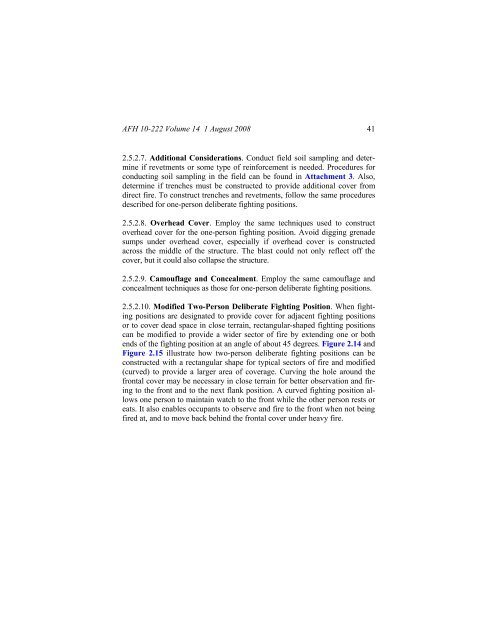Civil engineer guide to fighting positions, shelters, obstacles
Civil engineer guide to fighting positions, shelters, obstacles
Civil engineer guide to fighting positions, shelters, obstacles
Create successful ePaper yourself
Turn your PDF publications into a flip-book with our unique Google optimized e-Paper software.
AFH 10-222 Volume 14 1 August 2008 41<br />
2.5.2.7. Additional Considerations. Conduct field soil sampling and determine<br />
if revetments or some type of reinforcement is needed. Procedures for<br />
conducting soil sampling in the field can be found in Attachment 3. Also,<br />
determine if trenches must be constructed <strong>to</strong> provide additional cover from<br />
direct fire. To construct trenches and revetments, follow the same procedures<br />
described for one-person deliberate <strong>fighting</strong> <strong>positions</strong>.<br />
2.5.2.8. Overhead Cover. Employ the same techniques used <strong>to</strong> construct<br />
overhead cover for the one-person <strong>fighting</strong> position. Avoid digging grenade<br />
sumps under overhead cover, especially if overhead cover is constructed<br />
across the middle of the structure. The blast could not only reflect off the<br />
cover, but it could also collapse the structure.<br />
2.5.2.9. Camouflage and Concealment. Employ the same camouflage and<br />
concealment techniques as those for one-person deliberate <strong>fighting</strong> <strong>positions</strong>.<br />
2.5.2.10. Modified Two-Person Deliberate Fighting Position. When <strong>fighting</strong><br />
<strong>positions</strong> are designated <strong>to</strong> provide cover for adjacent <strong>fighting</strong> <strong>positions</strong><br />
or <strong>to</strong> cover dead space in close terrain, rectangular-shaped <strong>fighting</strong> <strong>positions</strong><br />
can be modified <strong>to</strong> provide a wider sec<strong>to</strong>r of fire by extending one or both<br />
ends of the <strong>fighting</strong> position at an angle of about 45 degrees. Figure 2.14 and<br />
Figure 2.15 illustrate how two-person deliberate <strong>fighting</strong> <strong>positions</strong> can be<br />
constructed with a rectangular shape for typical sec<strong>to</strong>rs of fire and modified<br />
(curved) <strong>to</strong> provide a larger area of coverage. Curving the hole around the<br />
frontal cover may be necessary in close terrain for better observation and firing<br />
<strong>to</strong> the front and <strong>to</strong> the next flank position. A curved <strong>fighting</strong> position allows<br />
one person <strong>to</strong> maintain watch <strong>to</strong> the front while the other person rests or<br />
eats. It also enables occupants <strong>to</strong> observe and fire <strong>to</strong> the front when not being<br />
fired at, and <strong>to</strong> move back behind the frontal cover under heavy fire.
















